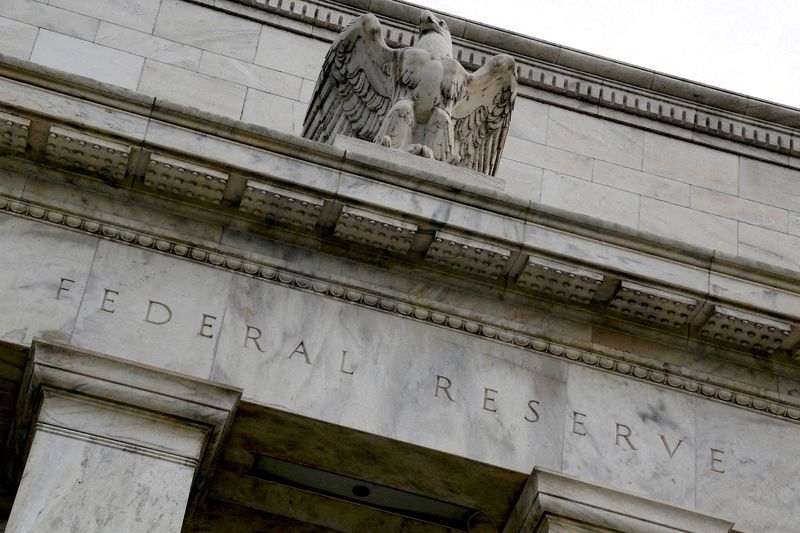By Howard Schneider
WASHINGTON (Reuters) - No one expects the Federal Reserve to change interest rates at next week's policy meeting, but whether officials hold to their previous rate-cutting outlook is a more open question as the economy keeps outperforming expectations.
Data since the Fed last met has confirmed policymakers' broadly shared baseline that their overnight interest rate will fall this year, with Fed Chair Jerome Powell telling U.S. lawmakers last week the central bank was "not far" from gaining enough confidence in declining inflation to reduce rates.
But policymakers' new projections will show whether they now anticipate fewer than the three quarter-percentage-point reductions this year estimated in December, or if they still think the economy can continue expanding while inflation continues to fall, allowing rates to fall as well.
It will be a vote, in effect, on whether improvements in the economy's supply dynamics and an unexpected jump in productivity can continue delivering a relatively pain-free easing of price pressures or if policymakers see slowing growth and tighter-for-longer policy as the cost of finishing their inflation fight.
"There's always been doubt about the durability of the recovery, but the economy keeps wanting to chug along," Bank of America Chief U.S. Economist Michael Gapen said last week, outlining what he called "a no-landing scenario" in which supply side improvements let the Fed begin reducing interest rates in June while inflation falls and the economy continues to grow at 2% or more for the year, above many estimates of its underlying potential.
Investors, who've blown hot and cold over whether a "soft landing" of low inflation and a low unemployment rate could be realized, also see a June start to rate cuts and will be looking for a signal about that when the Fed meets on March 19-20. The policy rate has been held steady in a 5.25%-5.5% range since July, a holding period between a final rate hike and rate cuts in line with previous monetary policy cycles.
MIXED SIGNALS
In December's projections, 11 of 19 policymakers saw at least three quarter-point cuts this year. As few as two officials taking a more hawkish view could shift the median forecast to suggest fewer cuts
A key piece of data, the Consumer Price Index for February, will be issued on Tuesday. Economists expect core CPI, which excludes food and energy prices, to slow from the 3.9% rate posted in January.
Even as investors have settled on a June rate cut, with a full percentage point in reductions expected this year, data - whether hard or anecdotal - since December's projections has been full of mixed signals.
The jobs report for February, for example, showed the unemployment rate rose to 3.9% from 3.7% and month-to-month wage growth slowed, evidence the super-tight job market that developed during the pandemic may be edging back to normal.
But headline job growth continues to run above average, hiring has become broader across industries, and wage growth measured year-over-year remains higher than the Fed feels is sustainable. Notably, the details of the jobs report show the rise in the unemployment rate reflected people joining the labor force, typically a sign of economic strength and confidence.
The rise in the unemployment rate was "driven by movements on the periphery," rather than a jump in job losses, said Nick Bunker, research director for North America at the Indeed Hiring Lab. The data showed a possible slowdown in the job-finding rate, he said, but still strong participation among workers in the key 25-to-54 year-old demographic.
The overall labor force rose for the first time in three months, by 150,000, helping keep the labor-force participation rate steady as around 1.9 million started a job search but had not yet landed employment - the biggest surge into the job market in more than two years.
'NOT SLOWING DOWN'
The Fed's most recent collection of field reports about the economy, known as the Beige Book, indicated either steady or growing activity in 11 of 12 Fed regional districts.
Based on contacts with businesses in the Southeast, Atlanta Fed President Raphael Bostic noted a sense of "pent-up exuberance" he said could stoke demand and price pressures if it all uncorked at once - just one of the "upside" inflation risks Fed policymakers have noted.
Inflation data itself has shown both overly strong consumer price reports, with a continued escalation of housing costs, and moderating wholesale price data that helped keep the Fed's targeted measure of inflation moving lower. The Personal Consumption Expenditures price index used by the Fed to set its 2% target rose 2.4% in January.
Even that close-to-target figure has left Fed officials reluctant to declare inflation dead or pin down the likely start of rate cuts.
Beyond Powell affirming reductions are likely this year, colleagues like Governor Christopher Waller insist the strength of the data leaves them in "no rush" to decide, while Governor Michelle Bowman and others have noted that rising asset prices and looser financial conditions could feed inflation and possibly signal Fed policy is not as strict as thought.
To some, that has left the outcome of the Fed's debate still up in the air.
"The Fed will not cut rates this year and rates are going to stay higher for longer," Torsten Slok, chief economist for Apollo Global Management (NYSE:APO) wrote in early March. "The reality is that the U.S. economy is simply not slowing down."
